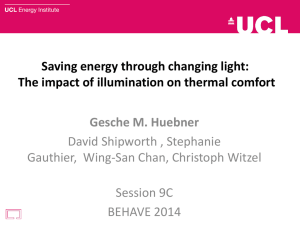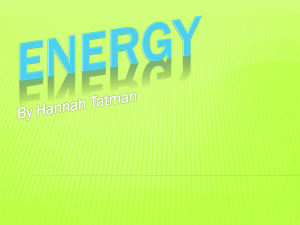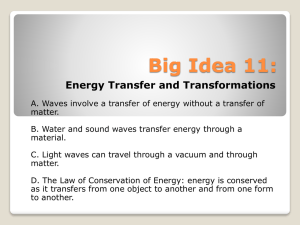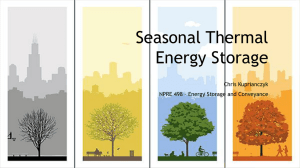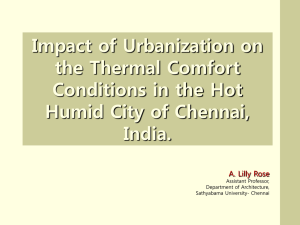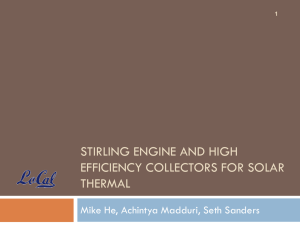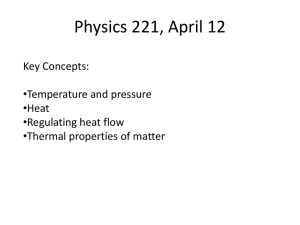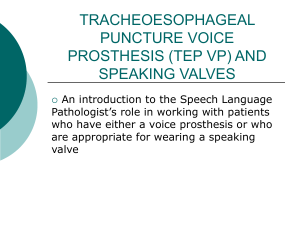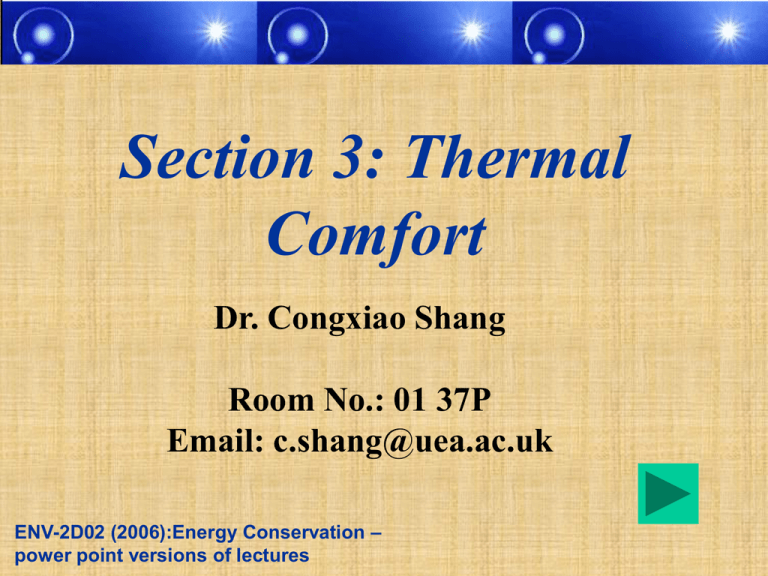
Section 3: Thermal
Comfort
Dr. Congxiao Shang
Room No.: 01 37P
Email: c.shang@uea.ac.uk
ENV-2D02 (2006):Energy Conservation –
power point versions of lectures
3.1 Introduction
Main objective: To examine whether an environment is
thermally comfortable at minimum energy consumption.
No two people will react the same in a
given environment
If all individual have the same clothing
that when the temperature is at the
optimum: 2.5% --- too cold; 2.5% ---- too
hot
Voting is normally done on the ASHRAE
scale ranging from -3 for too cold to +3 for
too hot
People who vote with values <-2 or > +2
are those who are at the extremes
3
very hot
Extremes
2.5
2
hot
1.5
1
slightly warm
0.5
0
neutral
-0.5
-1
slightly cool
-1.5
-2
cold
Extremes
-2.5
-3
very cold
3.1 Introduction
Main objective: To examine whether an environment is
thermally comfortable at minimum energy consumption.
The number of people voting at particular
values follows a Gaussian (normal)
distribution, which has its peak at a mean
vote of zero at an optimum setting.
If we respond only to complaints from
those who are feeling too cold or too hot
then we are likely to find that more people
will be dissatisfied as the curve will be
shifted to hotter or colder end.
3
very hot
Extremes
2.5
2
hot
1.5
1
slightly warm
0.5
0
neutral
-0.5
-1
slightly cool
-1.5
people who are too cold complain more
actively than the other way, with the
consequence that the temperature is often
kept unnecessarily high.
-2
cold
Extremes
-2.5
-3
very cold
3.1 Introduction
!!!!!
Bear in mind: for every 1oC, the energy
requirement rises by 8-10% (in the UK).
So: We need to be objective in any response
to complaints by investigating the overall
situation - not just the immediate problem of
one or two complainants
3.2 Thermal Comfort Theory
The perception of thermal comfort for an individual
depends on maintaining a balance between heat produced
by body and heat losses:
Heat generated by body, depending on metabolic rate --------H
Heat lost through respiration ----------------------------------R
1, Exhaust air is warmer than air taken in, AND
2, it is more moist - latent heat of evaporation
Heat lost through evaporation from skin (sweat) -----------------E
So net heat generated by body is (Q) from metabolic
Q = H -
R
-
E
3.2 Thermal Comfort Theory
Net heat generated by body is (Q)
To maintain a balance, this heat of value, Q, must be “removed”
by radiation (Qr) and convection (Qc) from the clothing in an
actual environment, as follows:
Q = H - R - E = Qr + Qc
If: Q > Qr + Qc
Q < Qr + Qc
3.3 Factors affecting thermal comfort
a)
b)
c)
d)
e)
f)
The air temperature
The mean radiant temperature
The relative humidity
The level of clothing
The activity level (Kcal.hr-1m-2)
The air velocity
3.3 Factors affecting thermal comfort
At a specific area, the mean radiant temperature within the area is
measured with a Globe Thermometer and is related to the
exchange of heat between a person and his/her surroundings.
However within a building:
We should consider the position you
are in the room for measurement,
Different walls have different surface
temperatures, e.g. internal walls,
external walls, windows etc. The mean
radiant temperature is different at
different points for measurements in
the building.
3.3 Factors affecting thermal comfort
At a specific area, the mean radiant temperature within the area is
measured with a Globe Thermometer and is related to the
exchange of heat between a person and his/her surroundings.
However within a building:
As an approximation, the AVERAGE
MEAN radiant temperature within a room
may be estimated by the following
( surface areas x surface temperatures)
total surface area
3.4 Calculation of average mean radiant
temperature
It is actually a mean temporal, mean spatial MRT!
Example:
Office Size: 3m x 3m x 3m (typical of UEA).
Windows: 2m high and full width of one wall.
3m
Internal surface temperature of windows: 8oC
2m
The external wall: 18oC.
The air-temperature: 20oC.
What is AMRT?
3m
3m
5 x 3 x 3 x 20 1 x 3 x 18 2 x 3 x 8 334
18. 56 C
6x3x3
18
o
3.4 Calculation of average mean radiation
temperature
How about with double glazing?
The internal surface temperature of the
windows would rise to around 14oC and
the AMRT is19.44oC, rather than 18.56oC
From the previous example, a rise of 1oC
in AMRT
Rise of Mean Vote
by around 0.11.
Therefore, There will be improvement
through double glazing in this room.
Alternatively we could reduce the air
temperature slightly to get the same
equivalent comfort level.
3m
double glazing
3m
2m
3m
3.5 Computation of thermal comfort level
Actual Thermal Comfort
Votes
– For the analysis of a particular
CLO level from thermal
comfort clothing chart
environment. Thermal comfort experiments
need to be done at particular conditions for
a large number of individuals
Their activity level
Predicted Mean Vote (PMV)
Wind speed
1, Computer prediction with Fanger’s
Equations
Air temperature
Humidity
Mean radiant temperture
A controlled environment
2, Manual use of the charts
3.5 Computation of thermal comfort level
Charts and tables for PMV at specific conditions
were produced according to both experimental data
and Fanger’s Equations
1) select table for appropriate metabolic rate, indicated by activity level.
2) select appropriate clothing level sub-table.
3) now read of vote value corresponding to air (dry-bulb) temperature and
air velocity (m/s) corresponding to wind speed.
Now how to obtain the PMV via the tables for other environments?
5) Use the Humidity correction chart which gives the correction for each
1% variation in humidity from 50%
6) Repeat for the Mean Radiant Temperature Correction chart i.e. for each
1oC that the MRT differs from the air (dry bulb) temperature.
7) Apply these corrections to the basic value to obtain the corrected PMV
(predicted Mean Vote).
8) Use further chart to estimate proportion of people likely to be
dissatisfied with thermal environment.
3.5 Thermal Comfort - Example
An office is 3m x 3m x 3m high with an external wall which is has a large 2m high
window on the full width of the external wall, facing North.
N
Internal air in the building: T = 19.5°C;
air velocity = 0.
Window
2
(19.5ºC)
3
1
17ºC
20ºC
3
3
The mean radiant T at a worker's desk:
- 17°C near the external wall,
- 18.5°C on the other sides of the room, and
- 20°C in a similar south facing room.
An office worker wearing clothing with a
CLO value of 1.0 and has an activity level of
60 kcal hr-1m-2 complains of being too cold.
What action would you take ?
3.5 Thermal Comfort - Example
Estimate Predicted Mean Vote (PMV);
- Consider Strategies
N
At 60 kcal hr-1m-2
Window
2
(19.5ºC)
3
1
Air Temp., °C
PMV
18
-0.75
20
-0.32
The same people at different activity levels
may feel comfortable at different temp.
17ºC
The corrections for MRT difference:
20ºC
3
3
At 50 kcal hr-1m-2
At 100 kcal hr-1m-2
correction is + 0.12
correction is + 0.06
3.5 Thermal Comfort - Example
Known values:
Air Temp., °C
PMV
18
-0.75
20
-0.32
At 60 kcal hr-1m-2
By linear interpolation:
Air Temperature, ºC
18
20
19
21
PMV
19.5
C’
-0.75
B
C
A
B’
?
-0.32
Predicted Mean Vote at: 19.5 °C =
-0.75 + (19.5 - 18) * [-0.32- (0.75)] /(20-18) = - 0.43
3.5 Thermal Comfort - Example
The same people at different activity levels may
feel comfortable at different temp.
The corrections for MRT difference:
MRT
Correction
At 50 kcal hr-1m-2
At 100 kcal hr-1m-2
0.12
Hence, the correction at 60 kcal hr-1m-2 :
?
0.06
50
correction is + 0.12
correction is + 0.06
60
100
Activity Level, KcalHr-1m-2
0.12 – (60-50) x [(0.12-0.06) / (100-50)]
= 0.11
3.5 Thermal Comfort - Example
Hence:
In North facing Office near window
PMV = - 0.43 + 0.11 * (17-19.5 ) = - 0.69
on other side of office
PMV = - 0.43 + 0.11 * (18.5 -19.5 ) = - 0.54
in south facing office
PMV = - 0.43 + 0.11 * (20-19.5) = - 0.37
N
Window
2
ACTION:
-Moving the desk to the other side of the room
or better still to a south facing office.
(19.5ºC)
3
1
17ºC
20ºC
3
3
- By complaining, an office worker must be
voting a PMV < -2, and yet the above PMV is
only slightly negative, suggesting that the person
always feels cold and should be encouraged to
wear an extra sweater.
( Increasing the CLO value to 1.25 will increase
the vote by about 0.3.)
Thermal Comfort Study: Arts 3.01 25th January 2006
Vote
all data
09:05
09:30
09:45
Metab
olic
Rate
58
70
55
50
Clo
1.15
1.16
1.15
1.17
Actual
0.28
0.71
0.17
-0.01
males
females
unknown sex
front of class
middle
window
58
58
58
58
58
58
1.17
1.16
1.15
0.79
1.21
1.25
0.30
0.23
0.48
0.42
0.16
0.49
PMV
0.22
0.60
0.12
-0.14
Sample Size 26
% dissatisfied Hot
Actual Predicted
2.63
4.80
7.69
9.50
0.00
3.60
0.00
1.60
MRT
21.3
22.0
21.5
20.5
Dry
20.3
20.2
20.2
20.4
Wet
16.3
16.2
16.3
16.4
80 Kcal.hr-1m-2 for a person who is standing.
Time seated
~ 5 minutes
~ 15 minutes
~ 30 minutes
~ 60 minutes
% dissatisfied Hot represent people voting +2 or more ~ 90 minutes
Predictions are reasonable for large numbers e.g. >100 > 2 hours
Activity Level (Kcal.hr-1m-2)
70
60
55
50
45
40
25
2.0
20
1.5
15
Actual
MRT
Wet
1.0
PMV
Dry
10
0.5
5
0.0
0
-0.5
-5
all data
09:05
09:30
09:45
Temperature
Vote
2.5
3.6 Thermal comfort summery
Thermal Comfort measurements may be used to assess a given
environment and are a useful additional aspect of Energy Management.
The level of comfort may be predicted using Fanger's Equations,
however, you should note the following:
It is difficult to accurately assess metabolic rate, and there is a tendency
to underestimate value for people who are seated unless they have been in
the particular Environment and at the particular activity level for at least
an hour.
Fanger's Theory strictly applies only to individuals having the same
clothing, but taking the mean values of a large number of votes should give
the same as Fanger’s.
If actual votes are available, then we can still use Thermal Comfort
Tables made under standard conditions, or the computer to assess the effects
of changes in the Environmental Conditions on the mean VOTE.
Rarely is actual thermal comfort data used in Energy Management
Decisions - responses are usually made for those who feel too cold without
identifying the real problem
Correction charts for the increment of PMV for each 1% variation in
humidity from 50%.
Correction charts for the increment of predicted mean vote for each 1oC
variation of mean radiant temperature from the air (dry-bulb) temperature.
PMV (predicted mean vote)
• It represents on a thermal sensation scale of the mean vote of a large
population of people exposed to a certain environment;
• It is derived from the physics of heat transfer combined with an
empirical fit to sensation;
• It establishes a thermal strain based on steady-state heat transfer
between the body and the environment and assigns a comfort vote to
that amount of strain.
• The PMV equation for thermal comfort is an empirical equation for
predicting the mean vote on a ordinal category rating scale of thermal
comfort of a population of people (not required here).
• PMV > 0 towards hot discomfort; PMV < 0 towards cold discomfort
Note: Thermal comfort- Clothing
(“CLO”)
“CLO” is a CLOthing insulation unit (Icl);
1 clo = 0.155 m2 °C/W;
Lowest clo value is 0 (naked body) ;
Highest practical clo value = 4 clo (Eskimo
clothing, fur pants, coat, hood, gloves etc.) ;
–
Summer clothing ~ 0.6 clo ;
–
Winter clothing ~ 1 clo .
–
–
–
–

